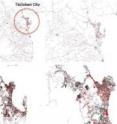Researchers propose network-based evaluation tool to assess relief operations feasibility
The United Nations Office for Disaster Risk Reduction reported that disasters have affected around 2.9 billion people worldwide from 2000-2012- killing more than a million, and damaging around 1.7 trillion US dollars in estimates. Moreover, natural disasters and their damages have been documented to occur with increasing intensity. Given the staggering numbers, effective disaster preparedness and relief response plans is compelling, especially considering the fact that natural disasters are usually unpredictable and damage cannot be avoided. Implementing a speedy and effectual outreach post-disaster is a nontrivial challenge "due to potential infrastructural changes such as destruction of road systems that make some highways impassable, and damage to the facilities and/or warehouses that serve as storage for relief supplies." A Singapore-based team of scientists from the Institute of High Performance Computing, A*STAR and The Logistics Institute-Asia Pacific has presented a model that looks into the logistics of disaster relief using open data and tools and measures developed in the field of network science. The work was recently published in the International Journal of Modern Physics C.
Based on OpenStreetMap- a collaborative project that provides open geodata to the world, the team reported a procedure that automatically converts a road map system into a road network of nodes and edges. It then utilizes contemporary tools in complex networks to assess several dynamics on the system, particularly, the flow of goods and other relief efforts, and quantify the reachability of critical loci within a geographic area where a disaster has struck. The proposed model is highly-flexible- allowing for inclusion of damage information, such as information coming from the Humanitarian OpenStreetMap team, in the analyses. The procedure developed also enables evaluation of the various effects of a range of possible hypothetical infrastructure destruction scenarios even before a disaster strikes a region-this was shown to be crucial in formulating contingency plans for the logistics of disaster response and relief operations.
To illustrate the utility of the methodology developed, the team considered the roadmap of the city of Tacloban in the central Philippines that was hit by Typhoon Haiyan, which claimed 6000 lives and displaced around 4.1 million more. Among others, the work quantifies the extent at which the inherent structure of the road network plays a role in facilitating, or hindering, landbound relief efforts, especially in the critical hours and days immediately following a disaster event. It also discusses the inaccuracy of assuming that road networks follow a structure similar to the more commonly studied scale-free, random, and/or grid (regular) network configurations.
This research was supported by Singapore A*STAR Complex Systems Programme research grant (# 1224504056 for EFL, CM) A*STAR SERC research grant (#1121790043 for JFV, XF, RG, RdS).
Source: World Scientific
Articles on the same topic
- Researchers propose network-based evaluation tool to assess relief operations feasibilityThu, 17 Apr 2014, 0:11:06 UTC
- Researchers propose network-based evaluation tool to assess relief operations feasibilityThu, 17 Apr 2014, 0:11:05 UTC
Other sources
- Researchers propose network-based evaluation tool to assess relief operations feasibilityfrom Science DailyWed, 16 Apr 2014, 18:44:22 UTC
- Researchers propose network-based evaluation tool to assess relief operations feasibilityfrom Science DailyWed, 16 Apr 2014, 18:44:23 UTC
- Researchers propose network-based evaluation tool to assess relief operations feasibilityfrom PhysorgWed, 16 Apr 2014, 15:20:31 UTC

